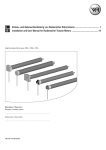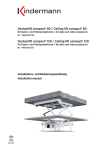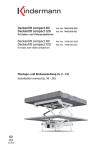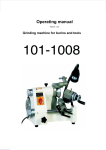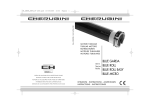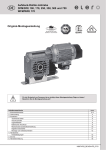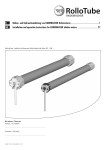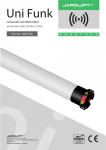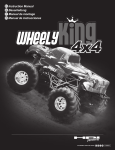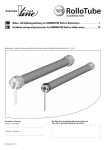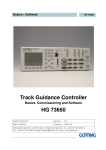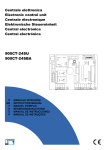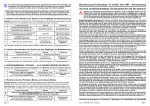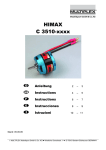Download D - Bauer Systemtechnik GmbH
Transcript
D GB Einbau- und Gebrauchsanleitung von Rademacher Rohrmotoren .......................................... 1 Installation and User Manual for Rademacher Tubular Motors ............................................... 14 Gültig für die Serien:/Valid for series: RTBS .../RTBM .../RTBL ... Bitte notieren: / Please note: / Montageort: / Installation location: ............................................................................................................................... .. Seriennummer: / Serial number: ............................................................................................................................... .. VBD 539-1-D-GB-(08.08) D Sehr geehrte Kunden... ...mit dem Kauf dieses Rohrmotors haben Sie sich für ein Qualitäts produkt aus dem Hause Rademacher entschieden. Wir danken Ihnen für Ihr Vertrauen. CE-Zeichen und Konformität Das vorliegende Produkt erfüllt die Anforderungen der geltenden europäischen und nationalen Richtlinien. Die Rademacher Rohrmotoren sind unter Aspekten des größten Komforts entstanden. Mit einem kompromisslosen Qualitätsanspruch und nach langen Versuchsreihen sind wir stolz, Ihnen dieses innovative Produkt zu präsentieren. Die Konformität wurde nachgewiesen, die entsprechenden Erklärungen und Unterlagen sind beim Hersteller hinterlegt. Dahinter stehen die hochqualifizierten Mitarbeiterinnen und Mitarbeiter aus dem Hause RADEMACHER. Diese Anleitung... ...beschreibt Ihnen die Montage, den elektrischen Anschluss und die Bedienung von Rademacher Rohrmotoren der Serien: RTBS.../RTBM.../RTBL... Bitte lesen Sie diese Anleitung vollständig durch und beachten Sie alle Sicherheitshinweise, bevor Sie mit den Arbeiten beginnen. Bitte bewahren Sie diese Anleitung auf und übergeben Sie die Anleitung bei einem Besitzerwechsel auch dem Nachbesitzer. Bei Schäden, die durch Nichtbeachtung dieser Anleitung und der Sicherheitshinweise entstehen, erlischt die Garantie. Für Folgeschäden, die daraus resultieren, übernehmen wir keine Haftung. Zeichenerklärung Lebensgefahr durch Stromschlag Dieses Zeichen weist Sie auf Gefahren bei Arbeiten an elektrischen Anschlüssen, Bauteilen etc. hin. Es fordert Sicherheitsmaßnahmen zum Schutz von Gesundheit und Leben der betroffenen Person. Hier geht es um Ihre Sicherheit. Beachten und befolgen Sie bitte alle so gekennzeichneten Hinweise. 2 D GB STOP So warnen wir vor Fehlverhalten, das zu Personen- oder Sachschäden führen kann. HINWEIS/WICHTIG/ACHTUNG Auf diese Weise machen wir Sie auf weitere, für die einwandfreie Funktion, wichtige Inhalte aufmerksam. Abbildungen / Illustrations 1 (2) (1) (3) (4) (5) (7) (6) (8) (9) (10) (11) (12) (13) (14) (15) (17) 2 4 D (18) RTBS .../RTBM ... 3 RTBL ... (19) (7.3) (8) min.X x (16) = (D/2) L (10) B C A (7.1) (7.2) L = A - (B + C) 5 (10) (5) (2) (8) (3) (9) (5) (4) 6 8 7 RTBS .../RTBM ... (1) (4) (5) (5) SW 50 SW 60 SW 70 (11) (12) (13) (6) (20) (5) SW 40 (14) (20) RTBL ... (17) (2) 3 D GB (6) D Allgemeine Sicherheitshinweise Bei allen Arbeiten an elektrischen Anlagen besteht Lebensgefahr durch Stromschlag. Bei unsachgemäßem Gebrauch besteht erhöhte Verletzungsgefahr. Der Netzanschluss des Rohrmotors und alle Arbeiten an elektrischen Anlagen dürfen nur durch eine zugelassene Elektrofachkraft nach den Anschlussplänen in dieser Anleitung erfolgen (s. Seite 8). Unterweisen Sie alle Personen im sicheren Gebrauch des Rohrmotors. Den sich bewegenden Rollladen beobachten und Personen fernhalten bis die Bewegung beendet ist. Verbieten Sie Kindern mit ortsfesten Steuerungen oder der Fernsteuerung zu spielen. Bewahren Sie Handsender so auf, dass ein ungewollter Betrieb, z. B. durch spielende Kinder, ausgeschlossen ist. Führen Sie alle Reinigungsarbeiten am Rollladen im spannungslosen Zustand aus. Führen Sie alle Montage- und Anschlussarbeiten im spannungslosen Zustand aus. Bei Nichtbeachtung besteht Lebensgefahr! Vorschriften bei Installation in Feuchträumen beachten. Beachten Sie besonders beim Einsatz in Feuchträumen die DIN VDE 0100, Teil 701 und 702. Diese Vorschriften enthalten zwingende Schutzmaßnahmen. Der Einsatz defekter Geräte kann zur Gefährdung von Personen und zu Sachschäden führen (Stromschlag, Kurzschluss) Verwenden Sie niemals defekte oder beschädigte Geräte. Prüfen Sie Antrieb und Netzkabel auf Unversehrtheit. WICHTIG Nach der Norm DIN EN 13695 muss dafür Sorge getragen werden, dass die für die Behänge festgelegten Verschiebebedingungen nach EN 12045 eingehalten werden. Dabei ist besonders darauf zu achten, dass die Ausfahrgeschwindigkeit des Behanges auf den letzten 0,4 m kleiner als 0,2 m/s sein muss. Wenden Sie sich bitte an unseren Service (s. letzte Seite), falls Sie Schäden am Gerät feststellen. Richtige Verwendung / Einsatzbedingungen Verwenden Sie die Rohrmotoren nur zum Öffnen und Schließen von Rollläden und Markisen. WICHTIG Das Motorkabel muss innenliegend im Leerrohr, unter Beachtung der örtlichen Elektrovorschriften, bis zur Abzweigdose verlegt werden. Verwenden Sie nur Original-Bauteile und -Zubehör des Herstellers. Einsatzbedingungen Für den elektrischen Anschluss muss am Einbauort ständig ein 230 V /50 Hz Stromanschluss, mit bauseitiger Freischaltvorrichtung (Sicherung), vorhanden sein. Wichtige Montagehinweise Gesamtansicht (Abbildung 1 ) 4 (1) (2) (3) (4) (5) (6) (7.1) (7.2) (7.3) (8) (9) (10) ( 11 ) (12) (13) (14) (15) (16) (17) (18) (19) (20) Gegenlager Kugellager Achsstift der Walzenkapsel Walzenkapsel Wickelwelle Befestigungsfeder Sicherungsclip (RTBS.../RTBM...) Sicherungsring (RTBL...) Paßfeder (RTBL...) Mitnehmer Rohrmotor Adapter 2 Einstellschrauben Antriebskopf Antriebslager Halteklammer Motorkabel Optional erhältlich: Steuerung (z.B. Troll C50) Rollladenpanzer Limitring Getriebeabtriebswelle Einhängeklammer D GB WICHTIG Vergleichen Sie vor der Montage die Angaben zur Spannung/ Frequenz auf dem Typenschild mit denen des örtlichen Netzes. Vor dem Einbau des Rohrmotors, alle nicht zum Betrieb benötigten Leitungen und Einrichtungen abbauen bzw. außer Betrieb setzen. Bewegliche Teile von Antrieben, die unter einer Höhe von 2,5 m vom Boden betrieben werden, müssen geschützt werden. Wird der Rohrmotor mit einem Schalter mit AUS-Voreinstellung gesteuert, ist dieser Schalter in Sichtweite des Rohrmotors anzubringen, aber von sich bewegenden Teilen entfernt, in mindestens 1,5 m Höhe. Die Wickelwelle unbedingt waagerecht montieren! Bei schiefer Aufwicklung des Rollladens können Schäden am Motor oder am Rollladen entstehen. Der Deckel des Rollladenkastens muss leicht zugänglich und abnehmbar sein. Vergleichen Sie nach dem Auspacken: den Packungsinhalt mit den Angaben zum Lieferumfang auf der Verpackung. den Motortyp mit den entsprechenden Angaben auf dem Typenschild. D GB Inhalt/Contents D Sicherheitshinweise ...................................................................4 Wichtige Montagehinweise .........................................................4 Einbau des Rohrmotors ..............................................................6 Montieren der Lager ...................................................................6 Einbau des Motors in die Lager ..................................................7 Sicherheitshinweise elektrischer Anschluss ................................8 Elektrischer Anschluss ................................................................8 Steuerung eines Antriebes/einpol. Rollladenschalter ...................8 Einstellung der Endpunkte ........................................................9 Montage des Rollladenpanzers ..................................................9 Probelauf/Verändern der Endpunkte .........................................10 Nothandkurbel ..........................................................................11 Was tun, wenn... ? ....................................................................12 Technische Daten .....................................................................13 Garantiebedingungen ...............................................................24 GB Safety instructions ......................................................................15 Important installation instructions.................................................15 Installing the tubular motor ..........................................................16 Mounting the bearings ................................................................16 Installing the motor in the bearings ..............................................17 Safety instructions for electrical connection ..................................18 Electrical connection ...................................................................18 Controlling a drive / single-pole roller blind switch .........................18 Adjusting the end stops ...............................................................19 Installation of the roller shutter curtain..........................................19 Test run / changing the end stops ................................................20 Emergency hand crank...............................................................21 What to do if ... ?........................................................................22 Technical data ............................................................................23 Warranty conditions ....................................................................24 D GB 5 D Einbau des Rohrmotors HINWEIS Die folgenden Einbauhinweise gelten für Standardeinbausituationen in Verbindung mit Rademacher-Rohrmotoren und -Zubehör. Der Antriebskopf (12) des Motors kann auf der rechten oder der linken Seite des Rollladenkastens eingebaut werden. In dieser Anleitung ist der Einbau für die rechte Seite dargestellt. Montieren der Lager (Abbildung 2 ) 1. Bestimmen Sie zuerst die Position von Antriebs- (13) und Gegenlager (1) im Rollladenkasten. 2. Befestigen Sie die Lager je nach Lagertyp und bauseitigen Gegebenheiten. Wickeln Sie den Rollladenpanzer vollständig auf die Wickelwelle und messen Sie den Durchmesser D. Siehe Abbildung 2 zur Bestimmung der Position der Lagermitte zur Führungsschiene. Montieren Sie das Antriebslager (13) so, dass die Einstellschrauben (11) später gut zugänglich sind und das Motorkabel ohne Knick verlegt werden kann. WICHTIG Im eingebauten Zustand muss der aufgewickelte Rollladen senkrecht in die Führungsschiene des Fensters einlaufen. Achten Sie auf den waagerechten Einbau der Lager. Ein schief auf gewickelter Rollladen kann den Antrieb blockieren und zerstören. Länge der Wickelwelle ermitteln (Abbildung 3 ) 1. Messen Sie den Wandabstand von Antriebs- (13) und Gegenlager (1) wie dargestellt. 2. Messen Sie den Rollladenkasten aus und ermitteln Sie die nötige Wellenlänge (L). Länge der Wickelwelle: L = A - (B + C) L 3. Die Wickelwelle (5) auf das nötige Maß kürzen. Sägen Sie die Welle mit einer Eisensäge rechtwinklig auf Maß. Entgraten Sie die Welle innen und außen mit einer Feile. B A C B = Gegenlager/Walzenkapsel C = Antriebslager/Motor Montage/Demontage von Adapter und Mitnehmer (Abbildung 4 ) 1. Montage des Adapters (10) 1. Schieben Sie den Adapter (10) über den Limitring (18) am Antriebskopf bis er einrastet. Achten Sie dabei auf die richtige Lage der Nut im Adapter (10). 2. Demontage des Adapters (10) Drücken Sie beide Haltefedern am Limitring (18) nach unten und ziehen Sie den Adapter (10) vom Limitring (18) ab. 6 D GB Montage des Mitnehmers (8) Schieben Sie den Mitnehmer (8) bis zum Anschlag auf die Achse (19) und sichern Sie ihn mit dem beiliegenden Sicherungsclip (7) 2. Demontage des Mitnehmers (8) Lösen Sie den Sicherungsclip (7) von der Achse (19) und demontieren Sie den Mitnehmer (8). D Rohrmotor in die Wickelwelle schieben (Abbildung 5 ) STOP Schlagen Sie nie den Motor (9) mit Gewalt in die Wickelwelle (5) ein. Das führt zu seiner Zerstörung. 1. Schieben Sie zuerst den Mitnehmer (8) in die Wickelwelle (5). 2. Drücken Sie danach die Wickelwelle (5) vollständig auf den Adapter (10). WICHTIG Achten Sie darauf, dass der Adapter (10) während der Montage nicht vom Limitring (18) am Antriebskopf (12) abrutscht, es kommt sonst zu Fehlfunktionen, s. Seite 12. WICHTIG Bei Wickelwellen mit innenliegender Falz muss der Motor (9) ausreichend Freiraum haben. Einstecken der Walzenkapsel (Abbildung 5 ) 1. Schieben Sie die Walzenkapsel (4) in die Wickelwelle (5) und stecken Sie anschließend das Kugellager (2) auf den Achsstift (3). Einbau des Motors in die Lager (Abbildung 6 ) 1. Antriebslager (13) - als Klicklager 2. Gegenlager (1) Drücken Sie den Antriebskopf (12) leicht in das Antriebslager (13), bis er eingerastet ist. Stecken Sie das andere Ende der Wickelwelle (5) mit dem Kugellager (2) in das Gegenlager (1). HINWEIS Die Einstellschrauben (11) müssen gut zugänglich sein. Falls Sie ein anderes Antriebslager als das Rademacher-Klicklager verwenden, müssen Sie jetzt ggf. den Antrieb mit einem zweiten Splint sichern. Die Rohrmotoren können in 4 Stellungen in das Klicklager (13) eingebaut werden. Durch Spreizen der Halteklammer (14) können Sie die Motoren jederzeit wieder aus dem Klicklager (13) lösen. Antriebslager (13) - alle anderen Lagervarianten Stecken Sie den Antriebskopf (12) an das jeweilige Antriebslager und sichern Sie ihn entsprechend, z.B. mit einem Splint. 3. Korrigieren Sie leichte Maßungenauigkeiten durch Einschieben oder Herausziehen der Walzenkapsel (4). WICHTIG Sichern Sie die Walzenkapsel (4) zum Schluss mit einer Schraube. Die Walzenkapsel (4) muss mindestens mit 2/3 ihrer Länge in der Wickelwelle (5) stecken. D GB 7 D Sicherheitshinweise zum Elektrischen Anschluss Bei allen Arbeiten an elektrischen Anlagen besteht Lebensgefahr durch Stromschlag. Bei festinstallierten Geräten... ...muss gemäß DIN VDE 0700, installationsseitig eine Trennvorrichtung für jede Phase vorhanden sein. Als Trennvorrichtung gelten Schalter mit einer Kontaktöffnungsweite von min. 3 mm (z. B. LS-Schalter, Sicherungen od. FI-Schalter). Der Netzanschluss des Rohrmotors und alle Arbeiten an elektrischen Anlagen dürfen nur durch eine zugelassene Elektrofachkraft nach den Anschlussplänen in dieser Anleitung erfolgen. Trennen Sie die Zuleitung allpolig vom Netz und sichern Sie sie gegen unbeabsichtigtes Einschalten. Kurzschlussgefahr durch Wasser bei falscher Kabelführung. Prüfen Sie die Anlage auf Spannungsfreiheit. Verlegen Sie das Motorkabel (15) nie direkt senkrecht nach oben, sonst kann evtl. Wasser über das Kabel in den Motor laufen und diesen zerstören. Verlegen Sie das Kabel in einer Schlaufe. Die Schlaufe bewirkt, dass am Kabel ablaufendes Wasser am tiefsten Punkt der Schlaufe gesammelt wird und dort abtropft. Führen Sie alle Montage- und Anschlussarbeiten nur im spannungslosen Zustand aus. Kurzschlussgefahr durch beschädigte Kabel. Verlegen Sie alle Kabel im Rollladenkasten so, dass diese nicht durch bewegliche Teile beschädigt werden können. STOP Elektrischer Anschluss (Abbildung 9 ) 9 1. Führen Sie das Motorkabel (15) nach dem Einhängen des Motors in die dafür vorgesehene Abzweig- oder Schalterdose. Farbskala der Motorleitung (15) (15) L1 ( / ) L1 L1 N PE = = = = Drehrichtung 1 Drehrichtung 2 Neutralleiter Erdung (schwarz) (braun) (blau) (grün/gelb) L1 ( / ) N PE Steuerung eines Antriebes mit einem einpoligen Rollladenschalter Installationsplan und Anschlussplan für die Montage an der rechten Seite. Steuergerät z.B. 1poliger Schalter/Taster 8 D GB blau schwarz L1 N PE grün / gelb Schalterdose 3 NETZ 230 V/50 Hz braun grün/ gelb 4 blau M schwarz M D Einstellung der Endpunkte 1. HINWEIS Führen Sie vorab einen Probelauf des Motors durch, ohne das der Rollladenpanzer eingehängt ist. Lassen Sie den Motor (über eine Zeitschaltuhr oder einen Schalter), in Richtung Tieflauf ( ) laufen, bis dieser selbstständig abschaltet. Vergewissern Sie sich bitte, dass dies die tatsächliche Abwärtsrichtung, also Tieflauf ( ) für Ihren Rollladen ist! Hat der Rollladenmotor die falsche Laufrichtung (Laufrichtung des Motors stimmt nicht mit der Schalterposition für Hochlauf ( ) und Tieflauf ( ) überein), vertauschen Sie die braune und die schwarze Ader in der Abzweig- oder Schalterdose. Setzen Sie jetzt den Motor weiter in Laufrichtung Tieflauf ( ) in Betrieb, bis die untere Endabschaltung erfolgt. Montage des Rollladenpanzers (Abbildung 7 / 8 ) Montieren Sie den Rollladenpanzer (17) mit Befestigungsfedern (6) (Zubehör) an der Wickelwelle (5). 2. STOP Nie im Bereich des Antriebs bohren oder schrauben um den Rollladen zu befestigen. WICHTIG Nur wenn der Motor in der Wickelwelle montiert ist, funktioniert die Endabschaltung. a. Schieben Sie die Befestigungsfedern (6) auf die oberste Lamelle des Rollladenpanzers (17). b. Setzen Sie alle 40 cm eine Befestigungsfeder (6) in die rechteckigen Löcher der Wickelwelle (5). c. Verwenden Sie bei Wickelwellen SW 40 (mit Außenfalz) Einhängeklammern (20) zur Montage der Befestigungsfedern (6); siehe Abbildung 8 . WICHTIG Die Endpunkte für oben und unten werden mit 2 Einstellschrauben eingestellt. Verwenden Sie dazu das beiliegende Einstellwerkzeug, um die Schrauben zu drehen. 3. Endpunkteinstellung Einstellschrauben * = Tieflauf Einstellwerkzeug = Hochlauf = Verlängerung des jeweiligen Laufweges = Verkürzung des jeweiligen Laufweges Bei Rechts-/ oder Linkseinbau: Mit der Einstellschraube am nach oben zeigenden Pfeil wird der untere Endpunkt eingestellt. Mit der Einstellschraube am nach unten zeigenden Pfeil wird der obere Endpunkt eingestellt. Drehen in Richtung + (Plus) bewirkt die Verlängerung des Laufweges. Umgekehrtes Drehen bewirkt eine Verkürzung. für die Plus- und Minusrichtung kann modellabhängig variieren. * Drehsinn Achten Sie auf die Bedruckung am Motorkopf! D GB 9 D Einstellung der Endpunkte 4. Oberer Endpunkt Fahren Sie den Motor in den Hochlauf ( ). Drehen Sie vorsichtig die entsprechende Einstellschraube mit dem beiliegenden Einstellwerkzeug in minus (-) Richtung bis der Motor abschaltet. Lassen Sie die Zeitschaltuhr oder den Schalter in der Schalterposition "Hochlauf" stehen und drehen Sie vorsichtig die entsprechende Einstellschraube mit dem beiliegenden Einstellwerkzeug in plus (+) Richtung bis der Motor den gewünschten Endpunkt erreicht hat. Sicherheitshinweis: Es können Temperaturunterschiede (Winter - Sommer) auf den Rollladenpanzer einwirken. Daher die Endlage für Hochlauf ( ) mit 2-3 cm “Luft” einstellen 5. Unterer Endpunkt (Nachjustierung) Fahren Sie den Motor in den Tieflauf ( ). Drehen Sie vorsichtig die entsprechende Einstellschraube mit dem beiliegenden Einstellwerkzeug in minus (-) Richtung bis der Motor abschaltet. Lassen Sie die Zeitschaltuhr oder den Schalter in der Schalterposition "Tieflauf" stehen und drehen Sie vorsichtig die entsprechende Einstellschraube mit dem beiliegenden Einstellwerkzeug in plus (+) Richtung bis der Motor den gewünschten Endpunkt erreicht hat. 6. Probelauf / Verändern der Endpunkte Kontrollieren Sie Ihre Einstellungen und lassen Sie den Rollladen in beide Richtungen laufen, bis die Endpunkte den Motor ausschalten. Thermoschutz Die Rohrmotoren sind für den Kurzzeitbetrieb (ca. 4 Min.) ausgelegt. Das Überschreiten dieser Zeit oder häufiges Umschalten führen zur Erwärmung. Lassen Sie den Motor in diesem Fall ca. 20 Minuten abkühlen. Verändern der Endpunkte Fahren Sie den Rollladen in die Mittelstellung zurück und beginnen Sie von vorn. Siehe Bild Endpunkteinstellung (Pos.3) auf Seite 9. 10 D GB D Nothandkurbel (Zubehör) HINWEIS Bei den Modellen der Serien RTBM...HK.. und RTBL...HK.. besteht bei Stromausfall oder Funktionsstörungen die Möglichkeit, den Rohrmotor per Nothandkurbel zur betreiben. Die Nothandkurbel ist Zubehör und nicht im Lieferumfang enthalten. ACHTUNG: Motor vor der Betätigung per Nothandkurbel unbedingt vom Netz trennen! Die Nothandkurbel darf nur bei Stromausfall bedient werden, außerdem ist darauf zu achten, dass die Endlagen nicht überfahren werden dürfen. Personen sind beim Handbetrieb von der Anlage fernzuhalten. a Die Nothandkurbel ist wegen Verletzungsgefahr oder Sachbeschädigung sofort nach Betätigung wieder aus der Anlage zu entnehmen. b Ausführungen mit Nothandkurbel (HK) Siehe: Technische Daten D GB 11 D Was tun, wenn...? Der Antrieb hebt bzw. senkt die Rolllade nicht, startet zu langsam oder mit lauten Geräuschen. ...der Rohrmotor im Normalbetrieb zwischen beiden Endpunkten stehen bleibt? Mögliche Ursache 1: Die Anschlüsse sind nicht korrekt. Mögliche Ursache: Der Thermoschutz hat angesprochen. Lösung 1: Überprüfen der Anschlüsse. Lösung: Den Motor ca. 20 Minuten abkühlen lassen. Mögliche Ursache 2: Falsche Installation oder Überlastung. Lösung 2: Überprüfen der Installation und Rollladenlast. ...der Rollladen im Hochlauf stehen bleibt? ...der Rollladen stoppt während des Hebens oder Senkens? Lösung: Vereisung bzw. Hindernis beseitigen. Mögliche Ursache 1: Erreichen des eingestellten Endpunktes. Lösung 1: Endpunkte erneut nach Anleitung setzen. Mögliche Ursache 2: Betriebsdauer überschritten (4 Min.). Lösung 2: Lassen Sie den Rohrmotor ca. 20 Minuten abkühlen. ...der Motor nicht läuft? Mögliche Ursache: Die Netzspannung fehlt. Lösung: Prüfen Sie mit einem Spannungsmessgerät ob die Versorgungsspannung (230 V) anliegt und überprüfen Sie die Verdrahtung. Beachten Sie besonders die Angaben zu den unzulässigen Anschlussarten. Überprüfen der Installation. ...die Drehrichtung falsch ist? Mögliche Ursache: Die Steuerleitungen sind vertauscht. Lösung: Trennen Sie die Zuleitung vom Netz und vertauschen Sie die schwarze/braune Ader des Motorkabels an Ihrer Steuerung. ...der Rohrmotor bei Einstellarbeiten und Probelauf nicht stoppt? Mögliche Ursache 1: Der Adapter (10) ist möglicherweise vom Limitring (18) am Antriebskopf (12) abgerutscht. Lösung 1: Prüfen Sie, ob der Adapter (10) bündig vor dem Antriebskopf (12) sitzt und vollständig in der Wickelwelle (5) steckt. Schieben Sie den Adapter (10) wieder bündig vor den Antriebskopf (12) und schieben Sie die Wickelwelle (5) vollständig auf den Adapter (10), s. Abbildung 5 . Stellen Sie ggf. die Endpunkte neu ein, s. Seite 9. Mögliche Ursache 2: Walzenkapsel nicht fixiert oder Rollladenwelle zu kurz. Lösung 2: Walzenkapsel fixieren oder passende Rollladenwelle einsetzen. 12 D GB Mögliche Ursache: Vereister Rollladen bzw. Hindernis in der Laufschiene. Rollladen in Abwärtsrichtung freifahren. D Technische Daten Motorserie Typ: RTBS ... 6/28 6 28 230 50 121 0,53 4 4 0,75 2,5 30 H I IP 44 * 472 35 2 Motorserie Typ: RTBM ... 10/16 10/16 20/16 20/16 30/16 30/16 40/16 40/16 50/12 50/12 HK HK HK HK 10 10 20 20 30 30 40 40 50 50 [Nm] 16 16 16 16 16 16 12 12 [U/min] 16 16 230 230 230 230 230 230 230 230 230 230 [V] 50 50 50 50 50 50 50 50 50 50 [Hz] 121 112 145 145 191 191 198 198 205 205 [W] 0,53 0,49 0,64 0,64 0,83 0,83 0,86 0,86 0,89 0,89 [A] [Min.] 4 4 4 4 4 4 4 4 4 4 4 4 4 4 4 4 4 4 4 4 0,75 0,75 0,75 0,75 0,75 0,75 0,75 0,75 0,75 0,75 [mm2 ] 2,5 2,5 2,5 2,5 2,5 2,5 2,5 2,5 2,5 2,5 [m] 30 22 22 22 22 22 22 22 22 22 [U] H H H H H H H H H H I I I I I I I I I I IP 44 IP 44 IP 44 IP 44 IP 44 IP 44 IP 44 IP 44 IP 44 IP 44 * * * * * * * * * * 472 474 474 574 544 624 544 624 544 624 [mm] 35 45 45 45 45 45 45 45 [mm] 45 45 2 2 2 2 2 2 2 2 2 2 HK = mit Notkurbel Nenndrehmoment: Leerlaufdrehzahl: Nennspannung: Frequenz: Nennleistung: Stromaufnahme: Einschaltdauer (KB): Anzahl der Adern: Aderquerschnitt: Kabellänge (Standard): Endschalterbereich: (Anzahl d. Umdreh.) Isolationsklasse: Schutzklasse: Schutzart n. VDE 700: Leitungsart: (* = Gummi) Motorlänge ohne Lager: Rohrdurchmesser: Anzahl parallel schaltbarer Rohrmotore (Bei Verwendung der Rademacher Steuerung, z.B. Troll C50) RTBL ... 60/15 60/15 80/15 80/15 100/12 100/12 HK HK HK 60 60 80 80 100 100 15 15 15 15 12 12 230 230 230 230 230 230 50 50 50 50 50 50 272 272 298 298 305 305 1,26 1,26 1,34 1,34 1,36 1,36 4 4 4 4 4 4 4 4 4 4 4 4 0,75 0,75 0,75 0,75 0,75 0,75 2,5 2,5 2,5 2,5 2,5 2,5 22 22 22 22 22 22 H H H H H H I I I I I I IP 44 IP 44 IP 44 IP 44 IP 44 IP 44 * * * * * * 658 658 658 658 658 658 60 60 60 60 60 60 2 2 2 2 2 2 120/9 120/9 HK 120 120 9 9 230 230 50 50 305 305 1,36 1,36 4 4 4 4 0,75 0,75 2,5 2,5 22 22 H H I I IP 44 IP 44 * * 658 658 60 60 2 2 [Nm] [U/min] [V] [Hz] [W] [A] [Min.] [mm2 ] [m] [U] [mm] [mm] HK = mit Notkurbel Nenndrehmoment: Leerlaufdrehzahl: Nennspannung: Frequenz: Nennleistung: Stromaufnahme: Einschaltdauer (KB): Anzahl der Adern: Aderquerschnitt: Kabellänge (Standard): Endschalterbereich: (Anzahl d. Umdreh.) Isolationsklasse: Schutzklasse: Schutzart n. VDE 700: Leitungsart: (* = Gummi) Motorlänge ohne Lager: Rohrdurchmesser: Anzahl parallel schaltbarer Rohrmotore (Bei Verwendung der Rademacher Steuerung, z.B. Troll C50) D GB 13 GB Dear Customers, ...By purchasing this tubular motor, you have chosen a quality pro duct from the house of Rademacher. We would like to thank you for your confidence. CE Mark and Conformity The present product complies with the requirements of the current European and national directives. Rademacher tubular motors have been developed for maximum convenience. With an uncompromising demand for quality, and after many series of tests, we are proud to present this innovative product. The conformity has been proved and the corresponding declarations and documentation are available on file at the manufacturer’s premises. The highly qualified employees of the house of RADEMACHER stand behind it. These instructions... ...describe the installation, electrical connection, and operation of Rademacher Tubular Motors of the series: RTBS.../RTBM.../RTBL... Before you begin work, please read these instructions through completely and follow all the safety instructions. Please save these instructions in a safe place and give them to any future owners. Damage resulting from non-compliance with these instructions and safety instructions will void the guarantee. We assume no liability for any consequential damage. Key to Symbols Danger of fatal electric shock This symbol warns of hazards when working with electrical connections, components, etc. It requires safety measures to protect the health and life of the affected person. This concerns your safety. Please pay particular attention and carefully follow all instructions marked with this symbol. 14 D GB STOP This symbol warns of malpractices that can result in personal injury or property damage. NOTE/IMPORTANT/CAUTION This is to draw your attention to information that is important for, trouble-free operation. GB General Safety Tips For any work on electrical systems, there is a risk to life due to electrocution. Inappropriate use causes increased risk of injury. Instruct everyone about the safe operation of the tubular motor. Only a certified electrician may connect the tubular motor to the power connection, or do any work on electrical systems, and only in accordance with the connection diagram in these instructions (see Page 18). Observe the moving shades, and keep people away until the motion is completed. Do not allow children to play with installed or remote controls. Perform any installation and connection work with the power disconnected. Store the hand transmitter such that undesired operation, such as by playing children, is impossible. Perform any cleaning tasks on the roller blind with the power disconnected. Failure to comply constitutes a hazard to life. Follow the regulations when installing in damp locations. For use in damp locations, take particular note of DIN VDE 0100, Part 701 and 702. These regulations contain mandatory protection measures. IMPORTANT According to the DIN EN 13695 standard, care must be taken that the curtain moving conditions according to EN 12045 are met. Special care must be taken that the travel speed of the curtain must be less than 0.2 m/s for the last 0.4 m. The use of defective devices can lead to hazards to persons and equipment damage (electrocution, short circuits) Never use defective or damaged devices. Check the drive and power cord for intactness. Please contact our Service Group (see last page) if you find damage to the device. Correct Usage / Operational Conditions Use the tubular motors only to open and close roller blinds and awnings. IMPORTANT The motor cable must be run inside the empty tube, in compliance with the local electrical codes, to the junction box. Use only original components and accessories from the manufacturer. Operational Conditions For the electrical connection, a 230 V/50 Hz power drop must be continuously available at the installation site, with a disconnect device (cut-out) provided by the customer. Important installation instructions Overall View (Figure 1 ) (1) (2) (3) (4) (5) (6) (7.1) (7.2) (7.3) (8) (9) (10) ( 11 ) (12) (13) (14) (15) (16) (17) (18) (19) (20) Counter bearing Ball bearing Axle pin on the roller capsule Roller capsule Winding shaft Tie Securing clip (RTBS.../RTBM...) Securing ring (RTBL...) Feather key (RTBL...) Driver Tubular motor Adapter 2 Adjustment screws Drive head Drive bearing Bracket Motor cable Optionally available: Controller (e.g. Troll C50) Roller shutter curtain Limit ring Gearbox output shaft Hanging brackets IMPORTANT Before installation, compare the voltage/frequency data on the rating plate with those of the local grid. Prior to installing the tubular motor, remove or disable any cables and devices not needed for operation. Moving parts on drives that are operated at a height of less than 2.5 m must be guarded. If the tubular motor is controlled by a switch with an OFF preset, this switch is to be mounted within line of sight of the tubular motor, but away from moving parts, at a height of at least 1.5 m. Always mount the winding shaft horizontally. If the roller blind is crooked when rolled up, the motor or the roller blind may be damaged. The cover of the roller blind box must be easily accessible and removable. After unpacking, compare: the package contents with the information on the scope of delivery in the package. the motor model with the corresponding information on the rating plate. D GB 15 GB Installing the tubular motor NOTE The following installation instruction apply to standard installation situations for Rademacher tubular motors and accessories. The drive head (12) of the motor can be installed on the right or left side of the roller blind box. Installation on the right side is shown in these instructions. Installing the bearings (Figure 2 ) 1. First, determine the position of the drive (13) and counter bearings (1) in the roller shutter curtain. 2. Mount the bearing, depending on the type of bearing and the building situation. Wind the roller blind shield completely onto the winding shaft, and measure the diameter D. See Figure 2 for determining the position of the centre of the bearing on the guide track. Assemble the drive bearing (13) such that the adjustment screws (11) will be accessible later, and the motor cable can be run without kinking. IMPORTANT When installed, the wound-up roller blind must run vertically in the guide track on the window. Take care that the bearings are level when installed. A roller blind that is crooked when wound up can jam and destroy the drive. Determine the length of the winding shaft (Figure 3 ) 1. Measure the distance from the drive (13) to the counter bearing (1), as shown. 2. Measure the roller blind box and determine the shaft length (L) needed. Length of the winding shaft: L = A - (B + C) L 3. Cut off the winding shaft (5) to the required dimension. Saw off the shaft squarely with a metal saw to the correct dimension. Deburr the shaft, inside and outside, with a file. B A C B = Counter bearing / Roller capsule C = Drive bearing / Motor Assembly / disassembly of adapters and driver (Figure 4 ) 1. Assembling the adapter (10) 1. 2. Disassembling the adapter (10) Press down on both retaining springs on the limit ring (18) and pull the adapter (10) off of the limit ring (18). 16 D GB Assembling the driver (8) Slide the driver (8) onto the axle (19) to the stop and secure it with the included securing clip (7). Slide the adapter (10) over the limit ring (18) on the drive head until it engages. Make sure the groove in the adapter (10) is correctly positioned. 2. Disassembling the driver (8) Remove the securing clip (7) from the axle (19) and disassemble the driver (8). GB Slide the tubular motor into the winding shaft (Figure 5 ) STOP Never strike the motor (9) violently to insert it in the winding shaft (5). This will destroy it. 1. First slide the driver (8) into the winding shaft (5). 2. Next, press the winding shaft (5) completely onto the adapter (10). IMPORTANT Take care that the adapter (10) does not slide off of the limit ring (18) on the drive head (12) during assembly, or a malfunction will occur; see Page 22. IMPORTANT For winding shaft with interior seams, the motor (9) must have sufficient clearance. Inserting the roller capsule (Figure 5 ) 1. Slide the roller capsule (4) into the winding shaft (5), then place the ball bearing (2) on the axle pin (3). Installing the motor in the bearings (Figure 6 ) 1. Drive bearing (13) - as a click bearing 2. Counter bearing (1) Press the drive head (12) lightly into the drive bearing (13) until it engages. Insert the other end of the winding shaft (5) with the ball bearing (2) into the counter bearing (1). NOTE The adjustment screws (11) must be accessible. If you are using a different drive bearing than the Rademacher click bearing, you may now need to secure the drive with another splint. The tubular motors can be installed in the click bearing (13) in 4positions. By spreading the bracket (14), you can remove the motors from the click bearing (13) again at any time. Drive bearing (13) - all other bearing variants Place the drive head (12) on the drive bearing and secure it appropriately, such as with a splint. 3. Correct for slight dimensional accuracies by sliding the roller capsule (4) in or out. IMPORTANT Secure the roller capsule (4) with a screw afterward. The roller capsule (4) must have at least 2/3 of its length inserted into the winding shaft (5). GB NL D GB 17 GB Safety instructions for electrical connection For any work on electrical systems, there is a risk to life due to electrocution. For fixed installation devices... ...A disconnect must be present for each phase on the installation side, according to DIN VDE 0700. Switches with a contact opening width of at least 3 mm (e.g., circuit breakers, fuses, or residual current devices). Only a certified electrician may connect the tubular motor to the power connection, or do any work on electrical systems, and only in accordance with the connection diagram in these instructions. Disconnect the feed from the grid on all poles, and secure it against unintended connection. Short circuit hazard due to water if cables are improperly routed. Test the system for zero voltage. Never route the motor cable (15) directly vertically, or water may run down the cable into the motor and destroy it. Route the cable in a loop. The loop ensures that water running down the cable is collected at the lowest point and drips from there. Perform any installation and connection work only with the power disconnected. Damaged cables present a short circuit hazard. Run all cables in the roller blind box, such that they cannot be damaged by moving parts. STOP Electrical connection (Figure 9 ) 9 1. Run the motor cable (15), after mounting the motor, in the junction box or switch box provided for it. Color codes for motor conductors (15) (15) L1 ( / ) L1 L1 N PE = = = = Rotational direction 1 Rotational direction 2 Neutral line Ground (black) (brown) (blue) (green/yellow) L1 ( / ) N PE Controlling a drive with a single-pole roller blind switch Installation layout and connection diagram for mounting on the right side. M Control device e.g., single-pole switch/button 18 D GB blue blue black L1 N PE green/yellow Switch unit 3 GRID 230 V/50 Hz brown 4 black green/yellow M GB Adjusting the end stops 1. NOTE Perform a test run on the motor first, without the roller shutter curtain in place. Let the motor run (using a time switch or a switch) in the down ( ) direction until it shuts off by itself. Please ensure that this is the correct downward direction, or down ( ), for your roller blind. If the roller blind motor is running in the wrong direction (motor running direction does not match the switch positions for up ( ) and down ( )), switch the brown and black conductors in the junction box or switch box. Now run the motor further in the down ( ) direction until it reaches the lower limit stop. Assembly of the roller shutter curtain (figure 7 / 8 ) Install the roller shutter curtain (17) on the winding shaft (5) using ties (6) (accessories). 2. STOP Never drill or screw into the area of the drive to mount the roller blind. IMPORTANT The limit stops work only if the motor is installed in the winding shaft. a. Slide the tie (6) onto the topmost segment of the roller shutter curtain (17). b. Place an tie (6) in the rectangular holes in the winding shaft (5) every 40 cm. c. For SW 40 winding shafts (with outer seams), use hanging brackets (20) to assemble the tie (6); see Figure 8 . IMPORTANT The end stops for the top and bottom are adjusted by means of 2 adjustment screws. Use the included adjustment tool to turn the screws. 3. End stop adjustment adjustment screws * = down adjustment tool = extension of each route = shortening each route = up For right or left-hand installation: The lower end stop is set using the adjustment screw on the arrow pointing upwards. The upper end stop is set using the adjustment screw on the arrow pointing downwards. Turning in the + (plus) direction extends the route. Turning the opposite way causes it to shorten. actual plus and minus directions may vary by model. * The Check the printing on the motor head. D GB 19 GB Adjusting the end stops 4. Upper end stop Run the motor in the up ( ) direction. Carefully turn the corresponding adjustment screw, using the enclosed adjustment tool, in the minus (-) direction, until the motor switches off. Leave the time switch or the switch in the "up" position, and carefully turn the appropriate adjustment screw in the plus (+) direction, using the included adjustment tool, until the motor has reached the desired end stop. Safety instructions: Temperature differences (winter - summer) may occur on the roller shutter curtain. Therefore, adjust the end position for up ( ) to have 2-3 cm of "air". 5. Lower end stop (readjustment) Run the motor in the down ( ) direction. Carefully turn the corresponding adjustment screw, using the enclosed adjustment tool, in the minus (-) direction, until the motor switches off. Leave the time switch or the switch in the "up" position, and carefully turn the appropriate adjustment screw in the plus (+) direction, using the included adjustment tool, until the motor has reached the desired end stop. 6. Test run / Changing the end stops Check your settings, and run the roller blind in both directions until the end stops switch off the motor. Thermal protection The tubular motors are designed for brief operation (approx. 4 min). Exceeding this time, or frequent switching back and forth, leads to heat build-up. In this case, let the motor cool for about 20 minutes. Changing the end stops Run the roller blind back to the centre position, and start again from the beginning. See Figure end stop adjustment (Pos. 3) on Page 22. 20 D GB GB Emergency hand crank (accessory) NOTE For the models in the RTBM...HK.. and RTBL...HK.. series, in case of power loss or malfunction, it is possible to drive the tubular motor with the emergency hand crank. The emergency hand crank is an accessory that is not included in the scope of delivery. CAUTION: Always disconnect the motor from the power supply before actuation with the emergency hand crank. The emergency hand crank may be used only in case of power loss; otherwise, note that the end stops may not be exceeded. Persons should stay clear of the system during hand operation. a The emergency hand crank must be removed from the system immediately after use, due to the risk of injury or property damage. b Versions with emergency hand crank (HK) See: Technical data D GB 21 GB What to do if...? The drive does not raise or lower the roller blind, starts too slowly or makes loud noises. ...The tubular motor stops between the two end stops during normal operation? Possible cause 1: Connections are incorrect. Possible cause: The thermal protection is engaged. Solution 1: Check connections. Solution: Let the motor cool for about 20 minutes. Possible cause 1: Incorrect installation or overload. Solution 2: Check the installation and roller blind load. ...the roller blind stops during upward travel? ...the roller blind stops during raising or lowering? Solution: Remove the ice or obstacle. Possible cause 1: The end stop was reached. Solution 1: Set the end stops again, according to the instructions. Possible cause 2: Running time exceeded (4 min.). Solution 2: Let the tubular motor cool for about 20 minutes. ...the motor does not run? Possible cause: Power supply is missing. Lösung: Use a voltmeter to check whether the supply voltage (230 V) is present, and check the wiring. Take note in particular of information about non-permissible types of connections. Check the installation. ...the rotary direction is wrong? Possible cause: Control lines are reversed. Solution: Disconnect the supply line from the power, and swap the black and brown conductors of the motor cable at the controller. ...The tubular motor does not stop for adjustments or test runs? Possible cause 1: The adapter (10) may have slipped off of the limit ring (18) on the drive head (12). Solution 1: Check whether the adapter (10) is fully seated in front of the drive head (12) and is completely inserted in the winding shaft (5). Slide the adapter (10) so that it contacts the front of the drive head (12) again, and slide the winding shaft (5) completely onto the adapter (10); see Figure 5 . Readjust the end stops if needed; see Page 19. Possible cause 2: Roller capsule not secured, or roller blind shaft too short. Solution 2: Secure the roller capsule, or use a roller blind shaft that fits. 22 D GB Possible cause: Ice on the roller blind or obstacle in the running track. Move the roller blind downward to free it. GB Technical data Motor series Model: Motor series Model: RTBS ... RTBM ... 6/28 10/16 10/16 20/16 20/16 30/16 30/16 40/16 40/16 50/12 50/12 HK HK HK HK 30 40 6 10 10 20 20 30 40 50 50 16 16 28 16 16 16 16 16 16 12 12 230 230 230 230 230 230 230 230 230 230 230 50 50 50 50 50 50 50 50 50 50 50 121 205 191 198 121 112 145 145 191 198 205 0.53 0.53 0.49 0.64 0.64 0.83 0.83 0.86 0.86 0.89 0.89 4 4 4 4 4 4 4 4 4 4 4 4 4 4 4 4 4 4 4 4 4 4 0.75 0.75 0.75 0.75 0.75 0.75 0.75 0.75 0.75 0.75 0.75 2.5 2.5 2.5 2.5 2.5 2.5 2.5 2.5 2.5 2.5 2.5 22 22 30 30 22 22 22 22 22 22 22 H H H H H H H H H H H I I I I I I I I I I I IP 44 IP 44 IP 44 IP 44 IP 44 IP 44 IP 44 IP 44 IP 44 IP 44 IP 44 * * * * * * * * * * * 624 624 472 472 474 474 574 544 544 544 624 45 45 35 35 45 45 45 45 45 45 45 2 2 2 2 2 2 2 2 2 2 2 [Nm] [rpm] [V] [Hz] [W] [A] [Min.] [mm2 ] [m] [R] [mm] [mm] HK = with emergency hand crank Nominal torque Idle speed: Nominal voltage: Frequency: Nominal power: Current draw: Duty cycle (KB): Number of conductors: Conductor sectional area: Cable length (standard): Limit switch range: (number of revolutions) Insulation class: Protection class: Type of protection per VDE 700: Type of conductor: (* = rubber) Motor length, without bearings: Tube diameter: Number of tubular motors that can be wired in parallel (When using the Rademacher controller, such as the Troll C50) RTBL ... 60/15 60/15 80/15 80/15 100/12 100/12 HK HK HK 60 60 80 80 100 100 15 15 15 15 12 12 230 230 230 230 230 230 50 50 50 50 50 50 272 298 298 305 305 272 1.26 1.26 1.34 1.34 1.36 1.36 4 4 4 4 4 4 4 4 4 4 4 4 0.75 0.75 0.75 0.75 0.75 0.75 2.5 2.5 2.5 2.5 2.5 2.5 22 22 22 22 22 22 H H H H H H I I I I I I IP 44 IP 44 IP 44 IP 44 IP 44 IP 44 * * * * * * 658 658 658 658 658 658 60 60 60 60 60 60 2 2 2 2 2 2 120/9 120/9 HK 120 120 9 9 230 230 50 50 305 305 1.36 1.36 4 4 4 4 0.75 0.75 2.5 2.5 22 22 H H I I IP 44 IP 44 * * 658 658 60 60 2 2 [Nm] [rpm] [V] [Hz] [W] [A] [Min.] [mm2 ] [m] [R] [mm] [mm] HK = with emergency hand crank Nominal torque Idle speed: Nominal voltage: Frequency: Nominal power: Current draw: Duty cycle (KB): Number of conductors: Conductor sectional area: Cable length (standard): Limit switch range: (number of revolutions) Insulation class: Protection class: Type of protection per VDE 700: Type of conductor: (* = rubber) Motor length, without bearings: Tube diameter: Number of tubular motors that can be wired in parallel (When using the Rademacher controller, such as the Troll C50) D GB 23 Firma Bauer Systemtechnik GmbH Geschäftsführer : Franz Bauer Freisinger Str. 9 D-84072 Au i.d. Hallertau Tel. : 0049 (0)8752 / 1600 Fax.: 0049 (0)8752 / 9599 www.torautomatik-shop.de Email: [email protected] Technische Änderungen, Druckfehler und Irrtümer vorbehalten. / Nos reservamos el derecho a cambios técnicos sin previo aviso, fallos de imprenta y equivocaciones. / Sous réserve de modifications techniques, de fautes d’impression et d’erreurs. / Subject to alteration. Errors and printing mistakes excepted. / Technische wijzigingen, drukfouten en vergissingen voorbehouden.
























